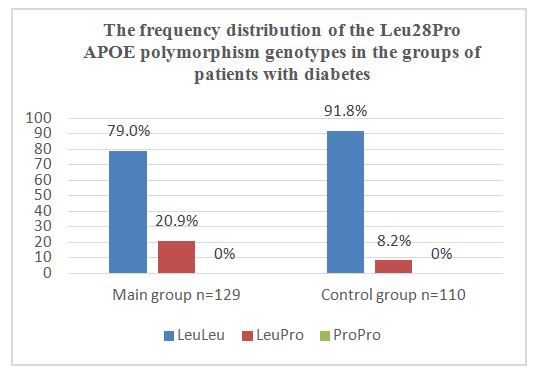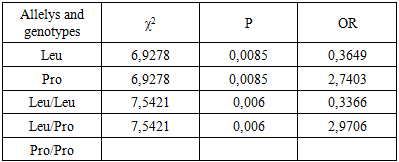-
Paper Information
- Next Paper
- Previous Paper
- Paper Submission
-
Journal Information
- About This Journal
- Editorial Board
- Current Issue
- Archive
- Author Guidelines
- Contact Us
American Journal of Medicine and Medical Sciences
p-ISSN: 2165-901X e-ISSN: 2165-9036
2020; 10(4): 212-214
doi:10.5923/j.ajmms.20201004.08

The Role of the Leu28Pro Polymorphic Marker of the APOE Gene in Progression Diabetic Nephropathy
Jabborov Ozimbay Otakhonovich
PhD, MD and Head o f the Deparatment of Faculty and Hospital Therapy №2, Tashkent Medical Academy, Tashkent, Uzbekistan
Correspondence to: Jabborov Ozimbay Otakhonovich , PhD, MD and Head o f the Deparatment of Faculty and Hospital Therapy №2, Tashkent Medical Academy, Tashkent, Uzbekistan.
| Email: |  |
Copyright © 2020 The Author(s). Published by Scientific & Academic Publishing.
This work is licensed under the Creative Commons Attribution International License (CC BY).
http://creativecommons.org/licenses/by/4.0/

The aim o f this study was to study 129 patients with type 2 diabetes and 110 healthy people to determine whether the Leu28Pro polymorphic markers o f the APOE gene are associated with the development o f diabetic nephropathy (DN). Patients in the main group: 65 patients with a disease duration o f up to 10 years, without diabetic nephropathy (33 patients) and with diabetic nephropathy (32 patients), 64 patients with diabetes lasting more than 10-20 years, with no diabetic nephropathy (31 patients) and diabetic nephropathy (33 patients). Genotyping was carried out by polymerase chain reaction. The study showed that the association o f the Pro allele and the Leu/Pro genotype o f the ENOS3 gene play a role in the development of diabetic nephropathy in patients with type 2 diabetes mellitus in the studied Uzbek nation.
Keywords: Diabetic nephropathy, Diabetes mellitus, Gene, Polymorphism, Allele, Genotype
Cite this paper: Jabborov Ozimbay Otakhonovich , The Role of the Leu28Pro Polymorphic Marker of the APOE Gene in Progression Diabetic Nephropathy, American Journal of Medicine and Medical Sciences, Vol. 10 No. 4, 2020, pp. 212-214. doi: 10.5923/j.ajmms.20201004.08.
1. Introduction
- Diabetic nephropathy (DN) is a microvascular complication of diabetes mellitus (DM), the development of which significantly worsens the course and further prognosis of the disease. With DN observed damage to the small blood vessels of the filtering apparatus of the kidneys, subsequently leading to an increase in the amount of protein excreted in the urine (proteinuria) [3,7]. DN develops in 13-15% of individuals in the general population and much more often - up to 40-50% - in risk groups, which include patients with type 2 diabetes [2,4]. According to the forecasts of the International Diabetes Federation, the number of patients with diabetes in the world will increase to 587 million people by 2035, of which 95% are patients with type 2 diabetes [1].In recent years, the risk of developing nephropathy is definitely determined by genetic factors. Only approximately 40-50% of patients with type 1 diabetes and type 2 diabetes subsequently develop DN [8]. Genetic factors can directly affect the development of DN and / or act in conjunction with genes that affect cardiovascular disease. The search for genetic markers of predisposition or, on the contrary, resistance to diseases is one of the most urgent tasks of medical science. [5,9]Previous studies of the association of a large group of candidate genes showed that only polymorphic markers of the angiotensin I converting enzyme gene (ACE) and the endothelial cell NO synthase gene vessels (NOS3) are associated with DN in patients with type 2 diabetes [6]. The association of genes encoding lipoproteins has not been previously studied among the Uzbek nation, although it is believed that one of the risk factors for DN in type 2 diabetes is an increased plasma lipid concentration, since certain groups of lipoproteins have a strong affinity for the vascular wall and can contribute to its damage. According to some reports, an altered lipid profile in the early stages may be the cause of the development of normoalbuminuric nephropathy in patients with type 2 diabetes.Therefore, genes encoding apolipoproteins B and E, individual concentrations and properties of which significantly determine lipid metabolism in a particular patient, are of undoubted interest for research as candidate genes that determine the predisposition to the development of vascular complications in type 2 diabetes.Target: To study the frequency distribution of alleles and genotypes and to identify the association of the Leu/Pro polymorphic markers of the APOE gene with the development of DM in patients with type 2 diabetes in individuals of Uzbek nationality.
2. Material and Methods
- In the Republican Scientific and Practical Center for Nephrology, on the basis of the III TMA clinic, the main group of 129 patients with type 2 diabetes was examined and the control group consisted of 110 healthy individuals Uzbek nation included on a case-control basis. Patients in the main group were divided as follows: 65 patients with disease duration up to 10 years, without diabetic nephropathy (33 patients) and with diabetic nephropathy (32 patients), 64 patients with diabetes lasting more than 10-20 years, without diabetic nephropathy (31 patients) and diabetic nephropathy (33 patients). We studied such indicators as the results of general blood and urine tests, lipid spectrum, glycemic profile, glycosylated hemoglobin, microalbuminuria, glomerular filtration rate (GFR) according to the CKD-EPI formula, the level of endothelin-1 in blood plasma, echocardiography, SMAD and dopplerographic examination of renal vessels. Testing the Leu/Pro polymorphism of the APOE gene was carried out on a programmable thermal cycler company "Applied Biosystems" 2720 (USA), using test systems of the company Litekh (Russia), according to the manufacturer's instructions.For statistical processing of the material, the STATISTICA 6 program was used. The data are presented as average values with a standard deviation. The normality of the distribution was checked by the Kolmogorov-Smirnov criterion. The relative risk of disease in carriers of a particular allele and genotype was calculated as an indicator of the odds ratio (OR - oddsratio). Genotype distribution was checked for deviation from Hardy-Weinberg equilibrium. The correlation coefficient r was calculated by the Spearman method. The differences were considered statistically significant at p <0.05.
3. Results and Its Discussion
- Allele and genotype frequency Leu28Pro polymorphism of the APOE gene in all patients (main group) and the control sample is shown in Figure 1.
 | Figure 1 |
|
4. Conclusions
- Thus, summarizing the data obtained, it can be concluded that there are undoubted involvement of a number of lipid metabolism genes in the development of DM in type 2 diabetes in individuals of Uzbek nationality. The results of this study indicate the importance of further studying the molecular basis of the development and progression of MDs will lead to the development of new promising directions in the prevention of this pathology.
 Abstract
Abstract Reference
Reference Full-Text PDF
Full-Text PDF Full-text HTML
Full-text HTML